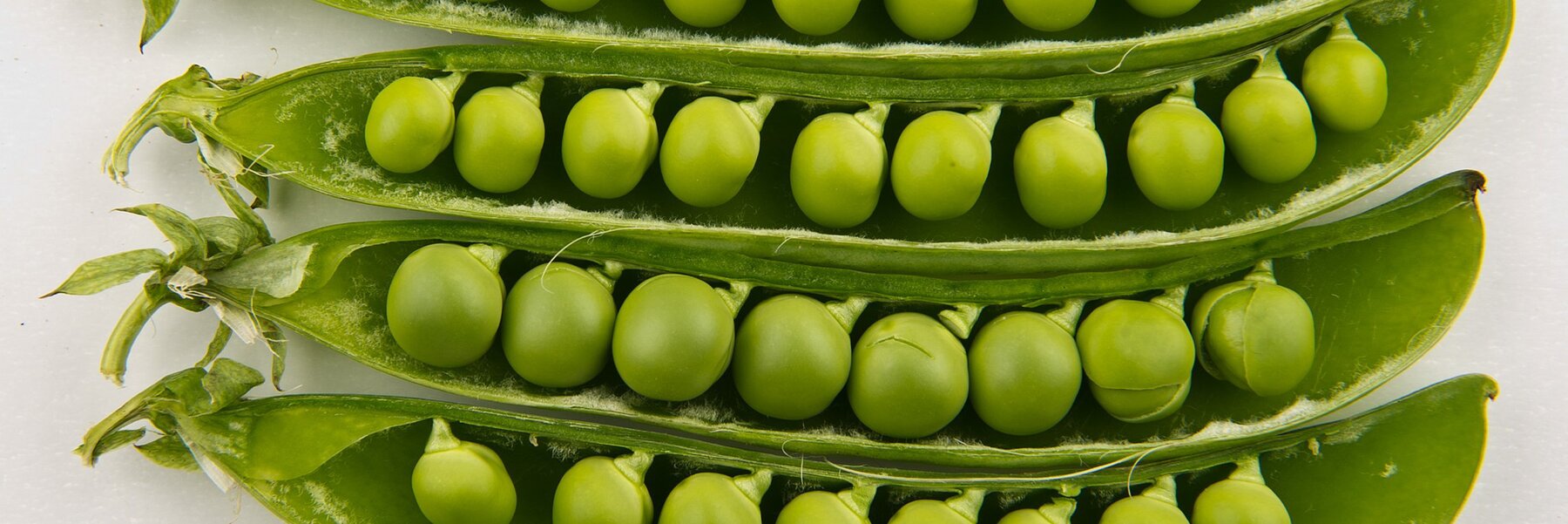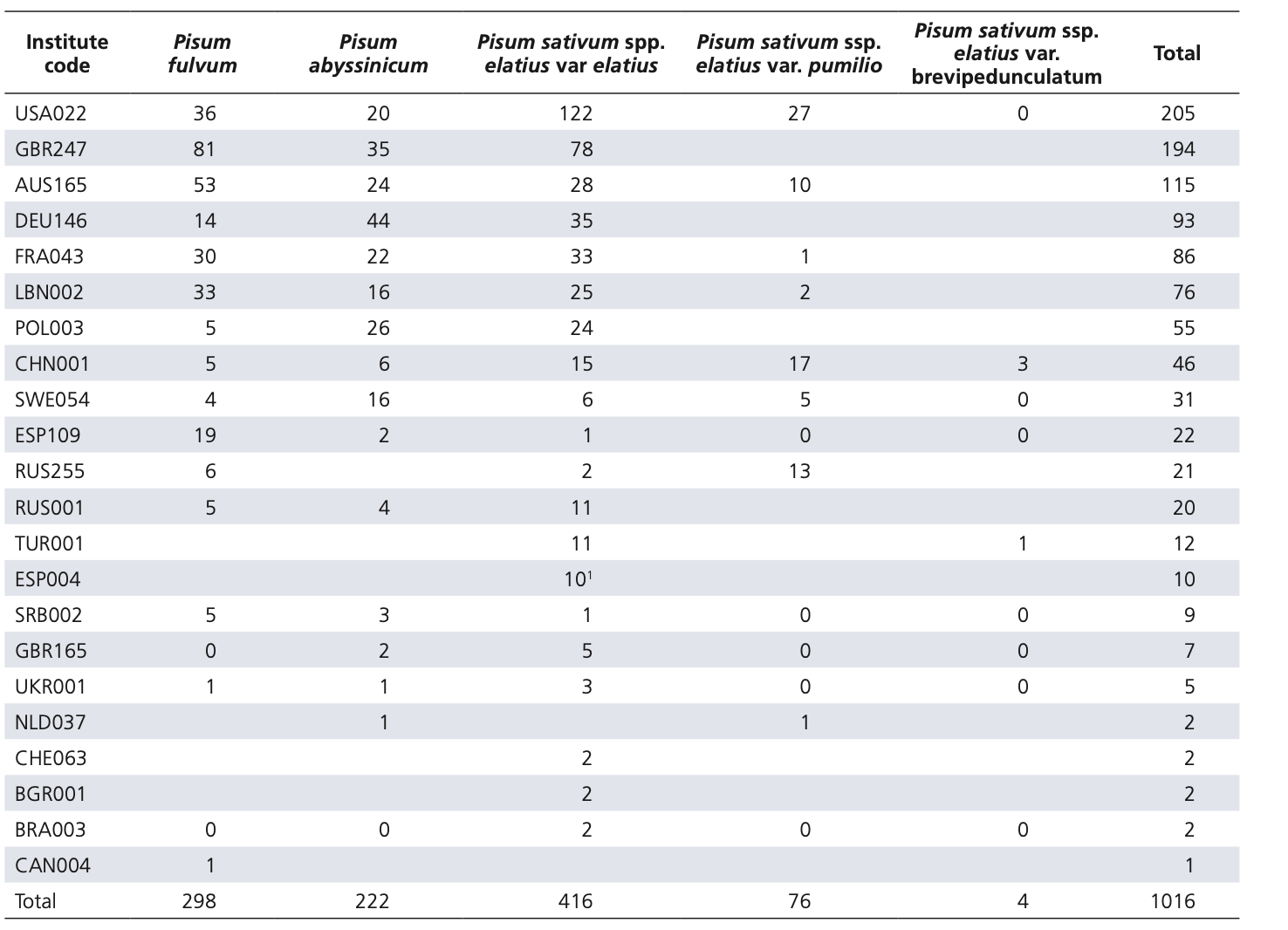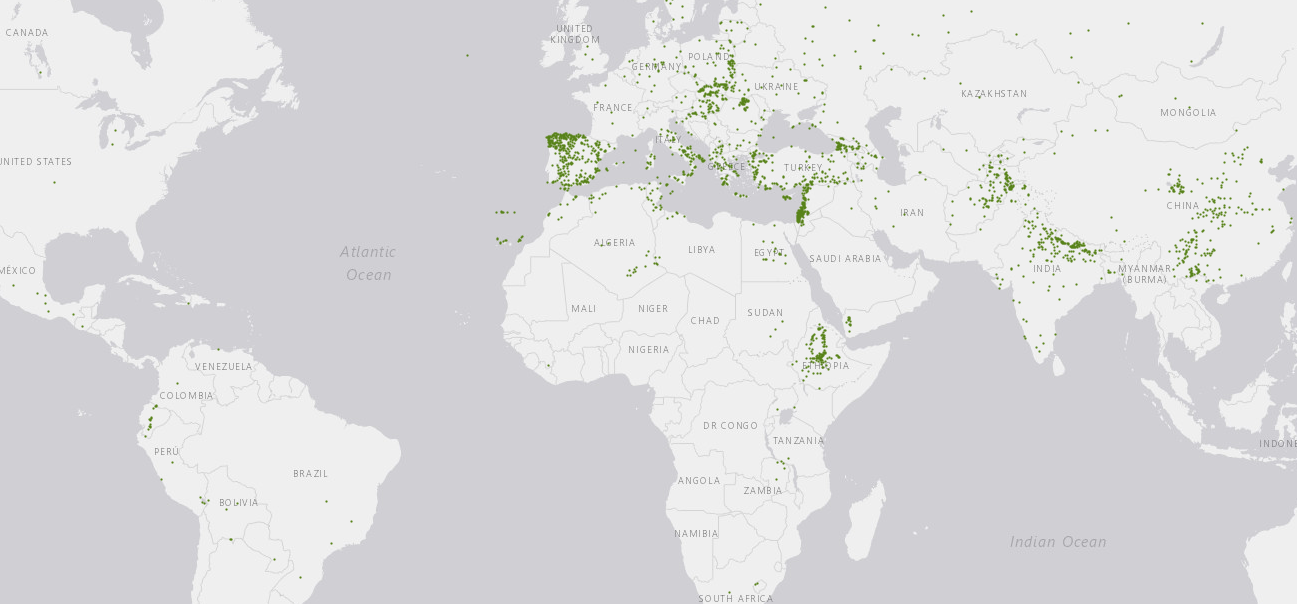Global Strategy for the Conservation and Use of Pea (Pisum sativum L.) Genetic Resources
Global Strategy for the Conservation of Pea Genetic Resources was published in 2022 (Global Crop Diversity Trust 2022, DOI: 10.5281/zenodo.7525946). This document, developed with the input of a large number of experts, aims to provide a framework for the efficient conservation and effective use of globally important collections of pea genetic resources. This webpage provides a summary of some of the its key findings and of the recommendations for priority actions.
Size of collections and their locations
Data from WIEWS, Genesys indicated a total of over 100, 000 Pisum acessions conserved in genebanks at the global level. The interactive bubble map below shows the combined data retrieved in 2023 from Genesys and WIEW.
Key collections
In terms of the number of accessions, the diversity of the collections (i.e., the number of countries of origin represented), and the number of accessions of landraces and CWRs, the following collections are particularly significant:
- FRA043, INRAE - UMR Agroecology, France
- RUS001, The NI Vavilov All-Russian Institute of Plant Genetic Resources, Russia
- CHN001, Institute of Crop Sciences, Chinese Academy of Agricultural Sciences, China
- AUS165, Australian Grains Genebank, Australia
- USA022, USDA Western Regional Plant Introduction Station, USA
- LBN002, ICARDA, Lebanon
- DEU146, Leibniz Institute of Plant Genetics and Crop Plant Research (IPK), Germany
- GBR247, The John Innes Centre, UK
- GBR165, SASA, UK
- POL003, Poznań Plant Breeders Ltd, Poland
- UKR001, Plant Production Institute named after VYa Yuriev of NAAS, Ukraine
- SWE054, NordGen, Nordic Genetic Research Centre, Sweden
- ITA394, CREA-Centro di Ricerca Zootecnia e Acquacoltura, Italy
- ETH085, Ethiopian Biodiversity Institute, Ethiopia
- ESP109, Instituto Tecnológico Agrario de Castilla y León, Spain
- ITA436, Istituto di Bioscienze e Biorisorse, Consiglio Nazionale delle Ricerche, Italy
- PAK001, Plant Genetic Resources Program, Pakistan
- CZE122, Crop Research Institute, Czech Republic
- BGR001, Institute of Plant Genetic Resources
- HUN003, Institute for Agrobotany, Hungary
- NLD037, Centre for Genetic Resources the Netherlands
- PRT001, Banco Português de Germoplasma Vegetal/INIAV
- GBR004, Royal Botanic Gardens Kew, UK
Pea accessions conserved ex situ by regions where they are stored
The bars show the number of accessions of cultivated and wild Pea species by regions where they are stored (i.e. the location of the genebanks).
Ex situ holding by biological type
The chart shows the number of Pisum accessions by biological type. For a large proportion of accessions conserved in genebanks the passport data in the open databases do not include information on the biological type of the accessions. The data was retrieved in 2023 from Genesys, WIEWS and GRIN-Global databases.
Pisum diversity tree
A diversity tree is a stratification of a genepool into groups and subgroups. The concept originated in a paper published by van Treuren et al. (2009) proposing a way to analyze and plan the composition of genebank collections. The diversity tree visualization is interactive (click on the tree to open it).
Recommendations for priority actions
- Priority action 1: Establish a global pea working group with representatives from key collection holders, breeders and research institutions
-
Priority action 2: Rationalize the global Pisum collection: the strategy authors recommend to rationalize collections by increasing data accessible on international PGRFA portals, improving passport data completeness, using digital object identifiers (DOIs), and genotyping all Pisum accessions conserved ex situ in key collections. These activities will create a global core collection and iden- tify unintended duplicates. We also recommend to establish written procedures and protocols to cover all routine operations in key Pisum collections.
-
Priority action 3: Acquisition priorities. Further collections of cultivated pea should prioritize landraces from Azerbaijan and Turkmenistan in the Caucasus; Southeast Asia; Iran in western Asia; South Africa, Kenya, and Malawi in Africa; Iraq, Israel, Jordan, Lebanon and Palestine in the Middle East; and Estonia, Lithuania, Finland, Norway and Belarus in Europe. Further collections of P. elatius should prior- itize North Africa, Iran and Jordan, and of P. fulvum should prioritize Turkey.
-
Priority action 4: Establish an ad hoc working group to formulate options for revising and standardizing morphological descriptors with reference to the development and adoption of plant and crop ontologies
Partners and donor
The development of this crop conservation strategy was funded by the German Federal Ministry of Food and Agriculture (BMEL) as part of the three-year project led by the Crop Trust: Breathing New Life into the Global Crop Conservation Strategies: Providing an Evidence Base for the Global System of Ex Situ Conservation of Crop Diversity. The Crop Trust also cooperated with the Secretariat of The International Treaty on Plant Genetic Resources for Food and Agriculture (ITPGRFA) in the development of this document.






